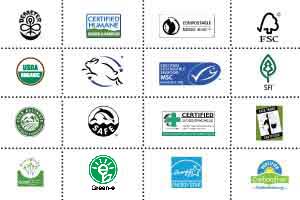
YOUR SHAMPOO BOTTLE is covered with labels proclaiming that its contents are all natural, cruelty free, and biodegradable, but is that actually true? There are more than 300 eco-labels out there, and not all are created equal. Official-looking seals created by industry groups can be misleading. Reassuring claims may be based solely on the manufacturer’s word. And some feel-good terms are so broad as to be meaningless. Below, we peel back some common eco-labels and rate them: Green means clean, yellow is okay, and red means buyer beware.
Print ‘n’ Save: Download a printable PDF version of this guide here.
Sort by:
GREEN: Best of the bunch
YELLOW: Better than nothing
RED: Virtually meaningless
FOOD/ORGANICS
![]() Biodynamic Demeter’s standard for “beyond organic” biodynamic food and wine requires biodiversity and zero pesticides on farms.
Biodynamic Demeter’s standard for “beyond organic” biodynamic food and wine requires biodiversity and zero pesticides on farms.
![]() 100% Organic The real deal for produce and packaged food.
100% Organic The real deal for produce and packaged food.
![]() Certified Organic Confusingly uses the same logo as 100% Organic and applies only to packaged foods and wine. Contents can be no more than 5% nonorganic.
Certified Organic Confusingly uses the same logo as 100% Organic and applies only to packaged foods and wine. Contents can be no more than 5% nonorganic.
![]() Food Alliance Requires farms to avoid GMO veggies or livestock, but they can still use pesticides.
Food Alliance Requires farms to avoid GMO veggies or livestock, but they can still use pesticides.
“Made with organic ingredients” The label that gave us (thank God) organic Oreos. USDA requires products’ total contents to be at least 70% organic.
“Natural” USDA-approved “natural” meat doesn’t contain artificial flavoring, preservatives, or synthetic ingredients. But “natural” steak can still have antibiotics and hormones.
“No additives” Implies a product doesn’t have ingredients like Red No. 40 or MSG. Or not—the maker decides what it means.
“Hormone free” Bull. Producers can call beef “hormone free” even if it contains hormones such as testosterone. By law, pork and poultry must be hormone free anyway.
ANIMAL CRUELTY
![]() Certified Humane Raised & Handled Meat came from an animal that lived a happy (as far as we know) life with space to move around.
Certified Humane Raised & Handled Meat came from an animal that lived a happy (as far as we know) life with space to move around.
![]() Leaping Bunny Cocreated by the Humane Society, this label is for cosmetics and cleaners without ingredients tested on animals.
Leaping Bunny Cocreated by the Humane Society, this label is for cosmetics and cleaners without ingredients tested on animals.
“Cruelty free” No set standards.
“Free range” No set standards for beef, pork, or eggs. The USDA lets poultry producers make this claim if chickens have “access” to the outdoors for 51% of their lives, not if they actually go out.
BIODEGRADABILITY
![]() Certified Biodegradable Soaps and cleaners with this third-party-certified label won’t hurt fish and will break down quickly.
Certified Biodegradable Soaps and cleaners with this third-party-certified label won’t hurt fish and will break down quickly.
![]() Compostable This label for eco-plastics adheres to stringent scientific guidelines.
Compostable This label for eco-plastics adheres to stringent scientific guidelines.
“Biodegradable” Under FTC rules, biodegradable products must “return to nature” when left to the elements. No one enforces this overly broad standard.
FISH/SEAFOOD
![]() Marine Stewardship Council For seafood that isn’t endangered or overfished. The only real eco-label for fish.
Marine Stewardship Council For seafood that isn’t endangered or overfished. The only real eco-label for fish.
![]() Dolphin Safe Tuna Means dolphins aren’t dying in tuna nets. But sea turtles, sharks, and other endangered species might be.
Dolphin Safe Tuna Means dolphins aren’t dying in tuna nets. But sea turtles, sharks, and other endangered species might be.
WOOD & PAPER
![]() Forest Stewardship Council Created by enviros, loggers, and consumers, this independently certified label requires timber and paper companies to monitor their supply chain.
Forest Stewardship Council Created by enviros, loggers, and consumers, this independently certified label requires timber and paper companies to monitor their supply chain.
![]() Sustainable Forestry Initiative Wood and paper come from forests where trees are replanted. Developed by a trade group, the label allows clearcutting and pesticides.
Sustainable Forestry Initiative Wood and paper come from forests where trees are replanted. Developed by a trade group, the label allows clearcutting and pesticides.
FLOWERS
![]() VeriFlora For flowers grown with good labor practices, without heavy-duty chemicals, on farms that are going organic. Certified by one of the best third-party investigators.
VeriFlora For flowers grown with good labor practices, without heavy-duty chemicals, on farms that are going organic. Certified by one of the best third-party investigators.
![]() Fair Trade Certified Flowers come from farms that pay good wages and help with health care and housing. Farms are encouraged but not required to avoid toxic chemicals.
Fair Trade Certified Flowers come from farms that pay good wages and help with health care and housing. Farms are encouraged but not required to avoid toxic chemicals.
![]() FlorVerde A mixed bouquet. Created by a Colombian trade group, FlorVerde lets growers use toxic pesticides. It requires better hours, wages, and working conditions—but not as aggressively as Fair Trade does.
FlorVerde A mixed bouquet. Created by a Colombian trade group, FlorVerde lets growers use toxic pesticides. It requires better hours, wages, and working conditions—but not as aggressively as Fair Trade does.
ENERGY
![]() Energy Star Appliances and electronics with this EPA label are the most efficient.
Energy Star Appliances and electronics with this EPA label are the most efficient.
![]() Green-e Marketplace This badge identifies companies that get their electricity from renewable sources.
Green-e Marketplace This badge identifies companies that get their electricity from renewable sources.
![]() Carbonfree Doesn’t mean a product is CO2 neutral, only that its maker bought offsets.
Carbonfree Doesn’t mean a product is CO2 neutral, only that its maker bought offsets.
OTHER
“Hypoallergenic” Created by cosmetics advertisers in the 1950s, it has no set meaning or standards.
“Fragrance free” Means only that a product doesn’t have a noticeable scent; it could still include chemicals that cover up odors.
“Nontoxic” Won’t kill your kids if they ingest it, but might contain chemicals that can cause serious health problems.
“Earth smart”/”Green”/”Nature’s friend” Meaningless.
















